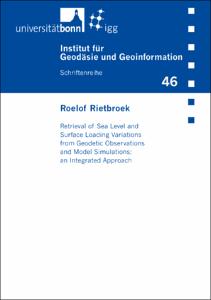Rietbroek, Roelof: Retrieval of sea level and surface loading variations from geodetic observations and model simulations : an integrated approach. - Bonn, 2015. - , . In: Schriftenreihe / Institut für Geodäsie und Geoinformation, 46.
Online-Ausgabe in bonndoc: https://hdl.handle.net/20.500.11811/1631
Online-Ausgabe in bonndoc: https://hdl.handle.net/20.500.11811/1631
@phdthesis{handle:20.500.11811/1631,
author = {{Roelof Rietbroek}},
title = {Retrieval of sea level and surface loading variations from geodetic observations and model simulations : an integrated approach},
school = {},
year = 2015,
series = {Schriftenreihe / Institut für Geodäsie und Geoinformation},
volume = 46,
note = {The mass distribution in the system Earth changes dynamically over time. Time-variable mass transport mainly arises from the interplay between the terrestrial hydrological water cycle, the ocean and atmosphere, and the Earth’s cryosphere. To understand the dynamics of the system Earth and its climate, it is of paramount importance to establish and maintain an accurate observational basis of these surface processes, against which models and theories can be tested.
A variety of observational techniques are used today. The time-variable gravity is measured from space by the Gravity Recovery and Climate Experiment (GRACE), Earth deformation processes are monitored by a permanent global network of GPS stations, and sea surface changes are detected by a family of satellite altimeters. The underlying motivation of this work is that the combination of the different observation types allows the mitigation of some of the technique-specific limitations. In the framework of this dissertation, several types of geodetic observations have been combined in a least-squares sense to estimate present-day changes of surface mass storage in the Earth system, using dynamically consistent surface loading theory.
Two types of inversion schemes have been designed and implemented. In the first scheme, time variable gravity from GRACE, deformations of a permanent GPS station network, and simulated ocean bottom pressure changes from an ocean model, are used to estimate weekly surface loading changes covering the entire globe. In the second inversion scheme, (inter-)annual changes of the Earth’s cryosphere, ocean and terrestrial water cycle, are parameterized by a predefined set of standing waves, whose time variations are estimated by combining GRACE gravimetry with satellite altimetry from Jason-1 and Jason-2.},
url = {https://hdl.handle.net/20.500.11811/1631}
}
author = {{Roelof Rietbroek}},
title = {Retrieval of sea level and surface loading variations from geodetic observations and model simulations : an integrated approach},
school = {},
year = 2015,
series = {Schriftenreihe / Institut für Geodäsie und Geoinformation},
volume = 46,
note = {The mass distribution in the system Earth changes dynamically over time. Time-variable mass transport mainly arises from the interplay between the terrestrial hydrological water cycle, the ocean and atmosphere, and the Earth’s cryosphere. To understand the dynamics of the system Earth and its climate, it is of paramount importance to establish and maintain an accurate observational basis of these surface processes, against which models and theories can be tested.
A variety of observational techniques are used today. The time-variable gravity is measured from space by the Gravity Recovery and Climate Experiment (GRACE), Earth deformation processes are monitored by a permanent global network of GPS stations, and sea surface changes are detected by a family of satellite altimeters. The underlying motivation of this work is that the combination of the different observation types allows the mitigation of some of the technique-specific limitations. In the framework of this dissertation, several types of geodetic observations have been combined in a least-squares sense to estimate present-day changes of surface mass storage in the Earth system, using dynamically consistent surface loading theory.
Two types of inversion schemes have been designed and implemented. In the first scheme, time variable gravity from GRACE, deformations of a permanent GPS station network, and simulated ocean bottom pressure changes from an ocean model, are used to estimate weekly surface loading changes covering the entire globe. In the second inversion scheme, (inter-)annual changes of the Earth’s cryosphere, ocean and terrestrial water cycle, are parameterized by a predefined set of standing waves, whose time variations are estimated by combining GRACE gravimetry with satellite altimetry from Jason-1 and Jason-2.},
url = {https://hdl.handle.net/20.500.11811/1631}
}






